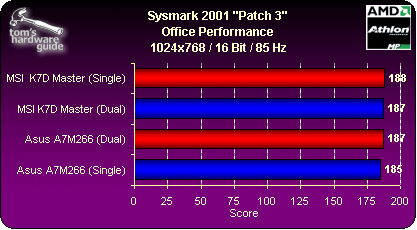3.2 GHz Athlon Power: Dual Boards From ASUS and MSI
Office-Performance: Sysmark 2001
The benchmark chart clearly shows that dual CPU systems offer hardly any improvement compared to single operation in the office test.
Linux Compilation: SuSE Linux 7.3 / Kernel 2.4.13
Compiling the Linux kernel is faster with one CPU than in dual operation. In addition, the Asus board is faster than MSI's counterpart.
The Memory Problem: Nothing Works Without Special Modules
Various DDR-SDRAM modules: above, a normal module; below, what is known as a "registered" memory.
To pre-empt unstable operating performance, dual Athlon boards should always be equipped with what are known as "registered" memory modules. Asus and MSI specify 4 GB as the maximum level of operating memory. It's a little different in practice: with "registered" memory, you can only expand up to 3.5 GB - if a conventional module is used, 3 GB is the maximum.
Get Tom's Hardware's best news and in-depth reviews, straight to your inbox.
Current page: Office-Performance: Sysmark 2001
Prev Page 3D-Rendering III: Cinema 4D XL R6 Next Page Summary: Dualie Has Its Benefits, And Not

